Servicios Personalizados
Revista
Articulo
Indicadores
-
 Citado por SciELO
Citado por SciELO -
 Accesos
Accesos
Links relacionados
-
 Similares en
SciELO
Similares en
SciELO
Compartir
Revista Latinoamericana de Desarrollo Económico
versión impresa ISSN 2074-4706versión On-line ISSN 2309-9038
rlde n.2 La Paz abr. 2004
RESEARCH PAPER
An Empirical Investigation of the Internet and International Trade: The Case of Bolivia*
Caroline L Freund**, Diana Weinhold***
Summary
This paper builds on Freund and Weinhold (2000) to show that the results of that paper can be applied to the case of Bolivia. We review the implications of the Freund and Weinhold model, emphasizing the effects of the Internet on increasing trade and lessening the effects of historical trading patterns in determining trade flows. Specifically, using a gravity model of trade for 56 countries including Bolivia, we show that the Internet stimulates trade and that Bolivia stands to gain an economically significant benefit from increased Web connectivity. Our results imply that a 10 percent increase in the relative number of web hosts in Bolivia would have led to about 1 percent greater trade in 1998 and 1999. The evidence is consistent with a model in which the internet creates a global exchange for goods, thereby reducing market-specific sunk costs of exporting.
1. Introduction
The internet is everywhere. Web statistics of staggering proportions and every variety constantly make their way into news reports and political speeches, and the phenomenon is not limited to the industrialized world. Anecdotal accounts of South American village women selling baskets to Swiss bankers, virtual medical advice being offered in Sub-Saharan Africa and other internet success stories have caught the imagination of more than one development agency. Both the UN and the IADB have special sections devoted to internet-related development initiatives, and at the Japanese meetings of the G-8 in 2000, the development agenda was dominated by talk not only of debt relief, but also of increased "wiring" up of the developing world.
The general excitement is shared by a number of academic economists as well. Danny Quah, Alan Blinder, Graciela Chinchilinsky and many others have written about the potential gains, and possible problems, that the new knowledge-based internet economy (the "weightless economy" in Professor Quah's parlance) may bring for developing countries. At the heart of the matter is increased technological transfer and lower transactions costs - the "death of distance" in the words of many a commentator.
There can be no doubt that very fundamental innovations are underway and that the internet is at the heart of matter. Nevertheless, so far most of the international evidence of systematic change has been primarily anecdotal in nature, and much of the statistical data available on the use of the web seems strangely disembodied. There are numerous "snapshot" figures of web use, growth of web use, and bandwidth usage etc. Academic studies of particular industries in certain countries carefully delineate the advantages and problems that firms have had to face in developing e-commerce opportunities. Innumerable policy documents talk about and emphasize the huge potential benefits of e-commerce for developing countries in international trade. However the authors of this paper have not been able to find any systematic, international statistical evidence of the effects of internet usage on trade patterns.
In recent papers, Freund and Weinhold (2000) and Freund and Weinhold (2003) (henceforth to be referred to as FW), we have attempted to fill a small part of this gap by asking whether the internet, anecdotes notwithstanding, has actually had a measurable, systematic impact on the observed patterns of international trade? If so, is it mostly a phenomenon of rich countries or has there also been some effect on the trading patterns of developing nations? FW (2000) and (2003) motives the empirical investigation with a trade model with imperfect competition and sunk costs and show that the internet has the potential to reduce market-specific sunk costs that have historically been very important for a large share of trade in goods.' Thus, the model implies that access to the Web has the potential to have the greatest impact on exports of countries that have not historically had strong trade ties. FW (2000) then uses a gravity model of international trade among 56 countries over the years 1995 to 1999 and find strong support for the predictions of the model. FW (2003) revises the theoretical analysis to focus on dynamic effects and extends the empirical testing to include a fixed effects panel data estimation. FW (2003) shows that the general implications of the results from FW (2000) are robust to this alternative form of estimation.
The predictions of the theoretical model in FW (2000) and (2003) have important implications for a country like Bolivia. In particular, it implies that access to the Internet could play a significant role in increasing trade ties by compensating for a lack of strong historical trade linkages. In this paper we examine the case of Bolivia in greater detail and consider the implications of Internet connectivity for the future evolution of Bolivia's international trade and competitiveness .
The paper proceeds as follows: Section 2 briefly reviews the main theoretical and empirical results from FW (2000). Section 3 examines the Bolivian case in more detail and section 4 concludes with a discussion of policy implications.
2. Testing for a Systematic Effect of the Internet on International Trade: A Review of the Main Results from Freund and Weinhold (2000)
2.1 Theoretical motivation
A number of recent papers have emphasized the importance of sunk costs in explaining trade flows (see, for example, Baldwin (1989), Eichengreen and Irwin (1998), Tybout and Roberts (1997), and Freund (2000)). Other models have emphasized the importance of local networks to overcome costs associated with imperfect information (see, for example, Rauch (1996, 1999, and 2000). In the former models with sunk costs, trade is distorted because some exporters do not enter a market (while others do not exit) as relative prices adjust. In the latter type of model with imperfect information, trade is distorted because search is costly. In this case the best matches are unlikely to be identified, and once matches are found they will not change because it is costly to find a new partner. Both types of models imply that trade patterns will be persistent, and indeed empirical work has shown that past trade flows have large and statistically significant explanatory power in predicting current patterns of trade, even after controlling for all the standard variables.
In the spirit of this literature FW (2000) present a simple theoretical model of trade (following Brander and Krugman [1983]) with imperfect competition, segmented markets and sunk costs in order to demonstrate the effects of the introduction of the Internet, and thus the creation of a global exchange, on trade The model yields three hypotheses about trade in a good produced in imperfectly competitive markets with fixed costs:
(i) A firm in a neighboring country is more likely to export and will export more than other firms because the fixed cost and the transport cost are both lower. A lower fixed cost directly increases the likelihood of exporting and a lower transport cost increases profits which also makes exporting more likely.
(ii) A firm is more likely to export to a large market.
(iii) History is important, the same exporters will always export in both periods in the two-period model.
Figure 1 shows an example of what a market of this type may look like. Producers sell directly to foreign markets, and some producers do not sell to some markets. Producers are more likely to sell to neighboring markets and to large markets. In addition, because of the fixed cost of entry, firms in a market have significant market power and prices vary across countries.
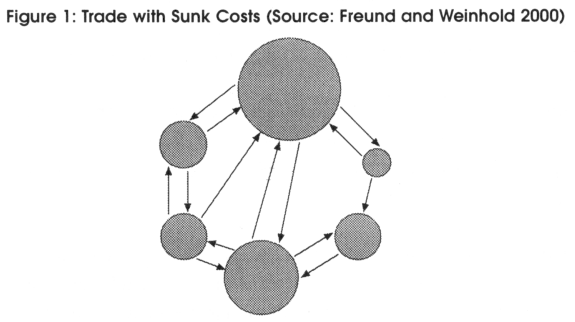
Next, they consider how trade is different with the internet. FW makes the point that the internet effectively aggregates world demand and world supplymarkets are no longer segmented. The market now appears as in Figure 2. Countries buy and sell on the international market. All importing countries gain because the price is lower. Exporting countries gain from access to new markets and reduction or removal of the fixed cost. Welfare is enhanced because information asymmetries are reduced, as all members of any given exchange share the same information.
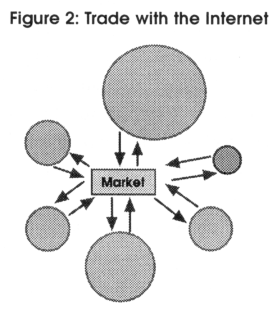
The model yields four predictions about how the internet will affect trade flows.
(i) Overall, trade will expand as the number of firms with access to the internet increases.
(ii) Access to the internet reduces hysteresis. While trade in the first period and in the second period might be the same with the internet, this would only be true if relative income and production remain unchanged,
(iii) Countries that exported to a small number of countries before the internet will have the greatest increase in trade.
(iv) The effect of distance on trade flows will be reduced if distance mainly influences trade because of information and hence sunk costs. If distance affects trade because of transport costs then the effect of the internet on this relationship is ambiguous.
The theoretical model also implies that the internet is also likely to increase world welfare. Increased competition implies that world prices should fall and converge. Since all countries buy from the world market, prices must be identical; in addition, without the market-specific sunk cost, competition is more intense so prices must be lower. Firms with established trade links may lose because they no longer have monopoly power. That is, firms that exported to a lot of countries in the past might lose because they are now forced to sell at a lower price. Similarly, countries that previously imported from only a few countries have a lot to gain in consumer surplus because the new price will be relatively lower.
In sum, the relevant innovation of the internet is that it has the potential to create large global markets for specific traded goods, both directly via organized exchanges with numerous buyers and sellers and indirectly through powerful search engines which enable sellers to notify buyers of prices instantaneously. This is very different from other recent innovations, such as the telephone or the fax, which only assist bilateral transactions. The advantage of such a global marketplace is that sunk costs associated with establishing trade ties can be drastically reduced, and information about new buyers or sellers can be made widely available. This has important implications for the size and pattern of trade flows among countries. Indeed, a recent survey of 50 global eMarketplaces found that these companies' values comes from aggregating buyers and sellers across regions. One executive from a Chemicals site noted thaf "lf a French chemicals company wanted to sell in China, it would spend a lot of money to expand into Asia. Now the firm can post on our site. The Chinese buyer looking for PVC is one click away from the French seller" (Sanders 2000b).
Finally, the possible effect of the internet on distance and trade is illustrated in Figure 3. The solid line shows the initial relationship between distance and trade. As distance between two countries increases, trade tends to fall, all else equal. The removal of information costs about distant markets shifts out the distance-trade locus, suggesting that the internet should reduce the effect of distance on trade. However, because transport costs can become more important, the slope of the line could increase, making the impact of distance on bilateral trade relatively higher.
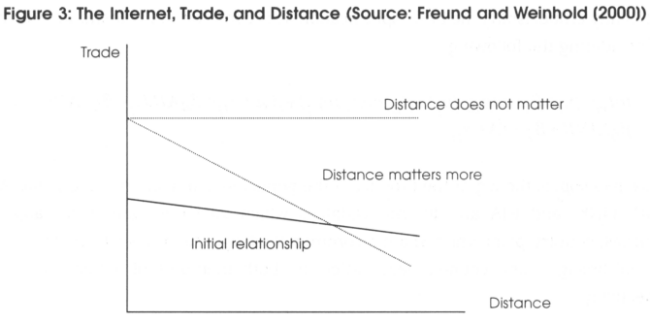
2.2 Empirical Investigation of the Effect of the Internet on Patterns of International Trade
FW (2000) presents a series of regression analyses designed to investigate the possible impact of increased web usage on patterns of international trade. In particular, they use a gravity model of trade among 56 countries for the years 1995 to 1999 to test some of the positive predictions of the model. Data on bilateral merchandise trade flows, GDP, and population are from the IMF. Data on geographic distances between countries is from Direct-Line Distances (1986). Data on common linguistic heritage and colonial links was compiled from Rand McNally and Co. Historical Atlas of the World (1994). Table 11 lists all of the countries included in the study.
The gravity equation is fundamentally based on the underlying "gravitational" relationship:
![]()
where TOT is the total bilateral trading volume between countries i and j. Taking logs on both sides produces the specification:
![]()
where gdpigdpj is the log of the product of the GNP's of country i and j.
Slightly embellishing the basic specification as is common in the literature, FW start by considering the following:

where popipopj is the log of the product of the populations of country i and j, and ADJ, LANG, LINK, and FTA are dummy variables which take the value 1 for adjacent countries, country pairs which share a common language, countries which share some colonial linkages, and country pairs which are both members of a free trade area, respectively.
In order to attempt to measure how "wired" a country is - in effect attempting to capture the "cybermass" of internet usage - FW use data from the Internet Software Consortium (ISC) to count how many web hosts are attributed to each country by counting top-level host domain names. A top-level domain name is either an ISO country code or one of the generic domains (com/org/net/etc).
However, as FW concedes, this is certainly not an ideal measure. ISC notes that, "There is not necessarily any correlation between a host's domain name and where it is actually located. A host with a NL domain name could easily be located in the U.S. or any other country. In addition, hosts under domains EDU/ORG/NET/COM/INT could be located anywhere. There is no way to determine where a host is without asking its administrator. ... In summary, it is not possible to determine the exact size of the internet, where hosts are located, or how many users there are" (www.isc.org).
Nevertheless FW notes that it is likely that their variable, HOST, is at least somewhat correlated with the relative quantity of host sites in each country. For example, even if a host site with a Bolivian top-level domain name is located in the USA, it is likely that the content of the web site is aimed at Bolivians. Thus, the number of "Bolivian" sites, regardless of physical location of the computers, should to a large extent reflect the "wiredness," or cybermass, of Bolivia.
In a series of gravity regressions, including extensive robustness and sensitivity testing, FW find no robust relationship between the internet and total trade in 1995 and 1996. However, from 1997 onwards, the internet shows a positive, increasing and statistically significant impact on the global pattern of trade flows. As predicted by the theoretical model, the effect of the internet is felt primarily through exports, and those countries with relatively more internet presence also display less dependence on historical determinants of trade such as a common language. Perhaps more importantly for the case of Bolivia, the results suggest that the benefits of the internet may accrue disproportionately to poorer countries, and are certainly no less important for developing countries than for industrialized nations. In general, the empirical results of FW imply that a 10 percent increase in the relative number of web hosts in one country would have led to about 1 percent greater trade in 1998 and 1999.
The results from FW reinforce the importance of policies aimed at reducing the "digital divide" between industrialized and developing countries. There is systematic and statistically significant evidence that increased internet access can have positive effects on the exports of poorer countries, and the theoretical model strongly suggests that these movements should be welfare enhancing.
Thus, if developing countries such as Bolivia are limited in their access to the World Wide Web they will not be able to take advantage of the benefits accruing to wealthier countries, and the rise of the Net will therefore be associated in increased global inequality. On the other hand, the results from FW suggest that given sufficient access to the internet, the overall effect of the web should be to lessen historically determined inequalities in trading patterns and to increase export opportunities for developing countries, thus reducing global inequality.
3. The Case of Bolivia
In this section we provide additional analysis of the case of Bolivia. In particular, we reproduce here some of the general evidence from FW (2000) that is most relevant for developing countries and show that these results do in fact apply to the specific case of Bolivia. We provide further figures on the relative extent of IT and web connectivity in Bolivia compared to other Latin American countries, and discuss importance of IT investment and Internet education initiatives for the future of Bolivia's international competitiveness.
Summary statistics on the total number of host sites and the number of host sites per 10,000 population by top-level domain name for the 56 countries in the sample are presented in the top panels of part A and B of Table 2.
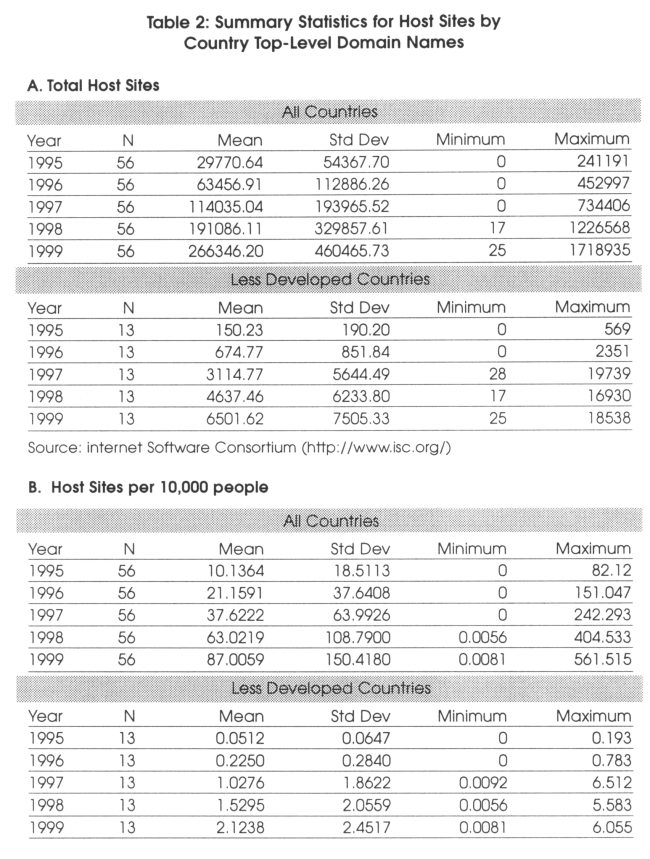
Between 1995 and 1997 the number of such host sites approximately doubles each year. In 1998 and 1999 this exponential rate slows slightly, but is still quite high. The lower panels of parts A and B of Table 2 present the same statistics for developing countries, defined as countries with 1995 per-capita income below $2,000. Table 3 presents the same information for Bolivia.
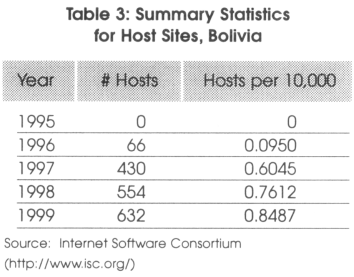
As Table 3 illustrates, there is a striking lag between Bolivia and most other LDC's in internet development. In particular the number of Bolivian host sites in 1999 is 632, which is a whole order of magnitude less than the average number of hosts for countries with per capita incomes under $2000/year. The per capita figures paint a slightly improved picture: Bolivia's average of 0.85 host sites per 10,000 persons is only about 40% of the sample LDC average of 2.1.
Table 4 puts this situation into a better context, comparing Bolivia's figures of per capita hosts sites in 1999 with those from a selection of countries at different levels of development.
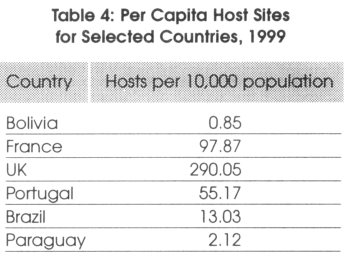
Table 5 presents a further comparison of a variety of per capita IT measures with other Latin American countries and table 6 presents the simple correlation between these variables.
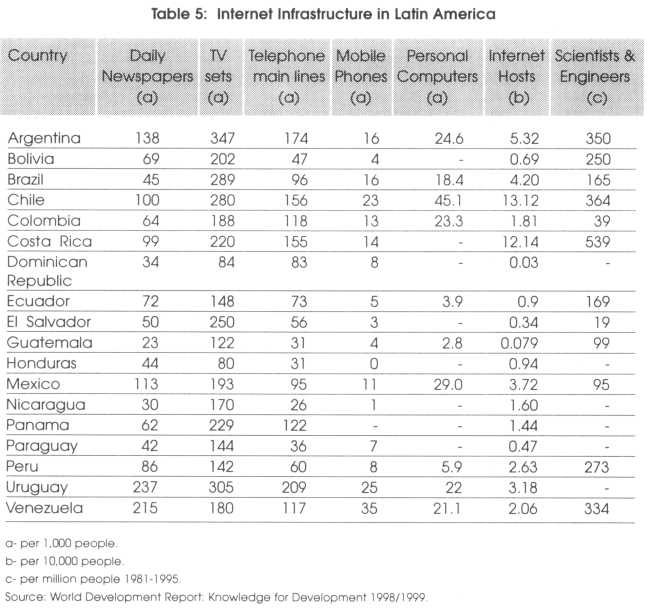
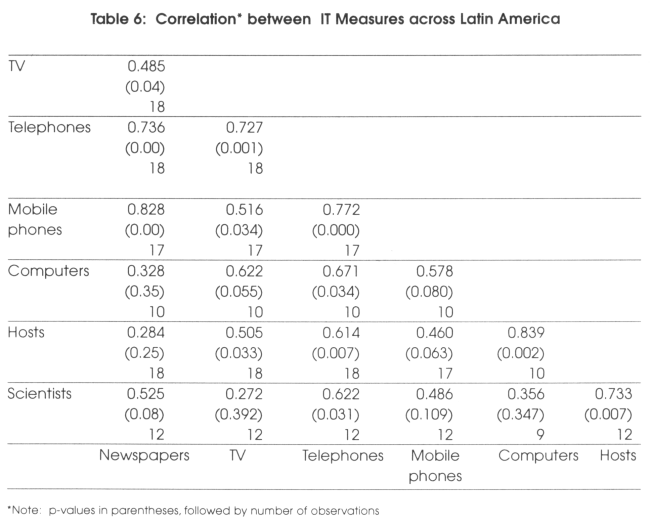
As would be expected, per capita host sites is highly correlated with both per capita computers, telephone lines and mobile phones. As might be expected, all of these variables are correlated with per capita income. In particular, for the countries in the FW sample the simple correlation between per capita GDP and per capita host sites is 0.705 and extremely statistically significant (i.e. p-value < .0001). Therefore it is not surprising that for these IT variables2 Bolivia ranks quite low, with levels comparable to the small Central American nations.
The clear observation that Bolivia faces a severe relative IT handicap immediately brings up the question of what benefits Bolivia might accrue from increasing its web connectivity. However, it is not enough to say that that would be a good thing: buying computers, installing phone lines and training personnel is costly and uses valuable scarce resources that might otherwise be used to construct schools, roads and other socially beneficial activities. It is beyond the scope of this paper to provide a complete cost-benefit analysis of "getting wired," but we can attempt to contribute towards this goal by providing some kind of idea of the trade increases which have accrued to developing countries generally from the Internet, and determining whether or not Bolivia is likely to enjoy the same level of benefit.
In table 7 we present the results of our gravity model of trade including past trade volumes from 1995. Including a lagged dependent variable provides a control for many unobservable characteristics and is thus our preferred overall model from which we derive our final empirical estimates. In addition, we add to the basic specification a dummy variable for Bolivia and the Bolivia dummy interacted with our HOST variable. If we do not control for past trade values, the Bolivian dummy variable is negative and statistically significant3, indicating that on average Bolivia has less trade than would be expected taking into account GDP, population, distance to trading partners, language and colonial links and free trade agreements. However, in the results presented in table 6 the lagged dependent variable captures this fact and the single Bolivian dummy is not statistically significant.
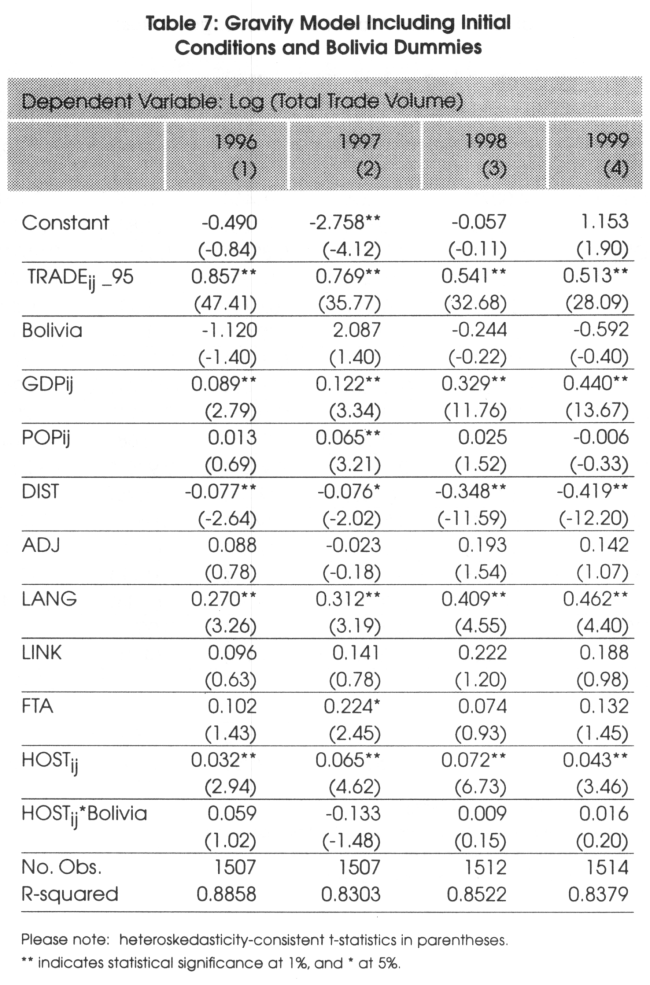
Most importantly, the coefficient estimate on the HOST variable is identical to the analogous results in FW, and the interaction variable of the Bolivian dummy and our HOST variable is not statistically significant. This result indicates that there is nothing systematically different about Bolivia that differentiates it from other countries when it comes to the relationship between Internet hosts and international trade. In other words, we have found no evidence that Bolivia would not receive the same benefits as any other country for an increase in Web connectivity.
Having established that the FW results can be generalized to the specific case of Bolivia, tables 8 and 9 are reproduced here directly from FW. The results from table 8 show that an increase in relative host sites benefits poorer countries at least, if not more, than it benefits rich countries. In particular, when we interact our HOST variable with dummy variables for rich-rich, rich-poor, and poor-poor country trading pairs we find that the largest coefficient estimates are for poor-poor country pairs, followed by rich-poor and finally, with the smallest estimates of the trade effects of a relative increase in hosts, are the rich-rich country trading pairs. The differences between the coefficient estimates are not large, but the pattern is similar over the sample period and is consistent with FW's theoretical results which imply that the benefits of the Internet will accrue to those countries who historically had fewer trade ties. Thus, a conservative conclusion from these results is that the Internet plays at least as important a role in developing countries, and thus by association in Bolivia, as in industrialized countries. In other words, the Web is not intrinsically an exclusive club enjoyed only by the rich.
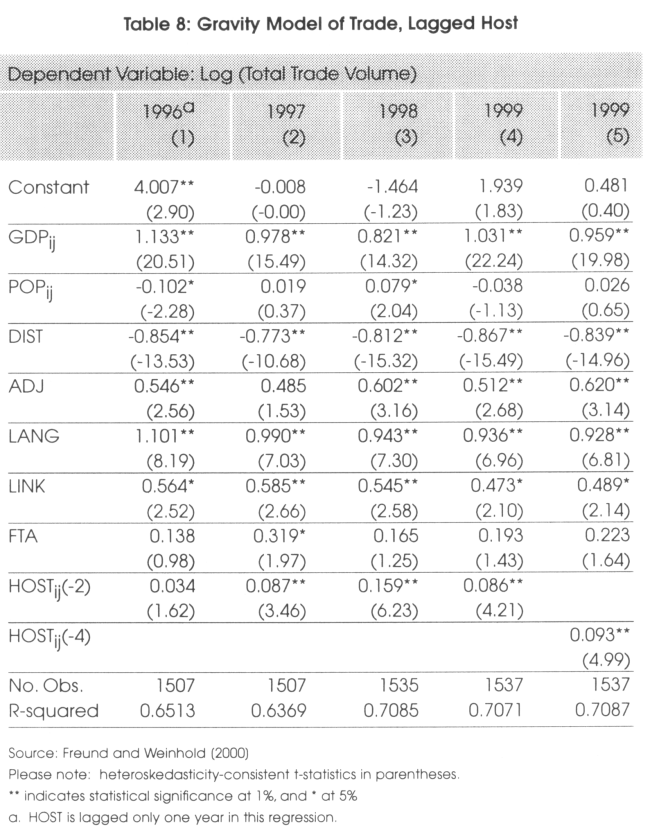
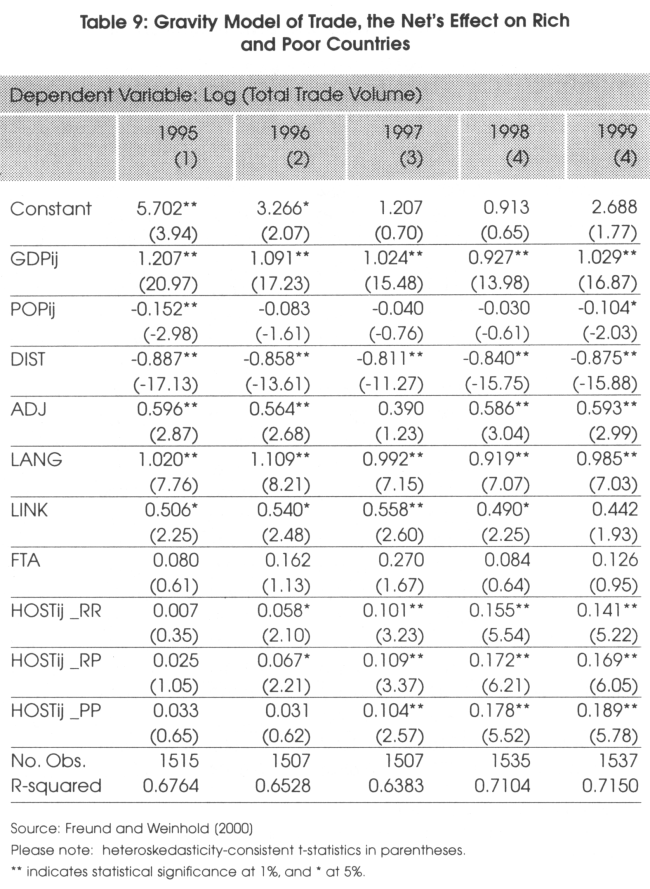
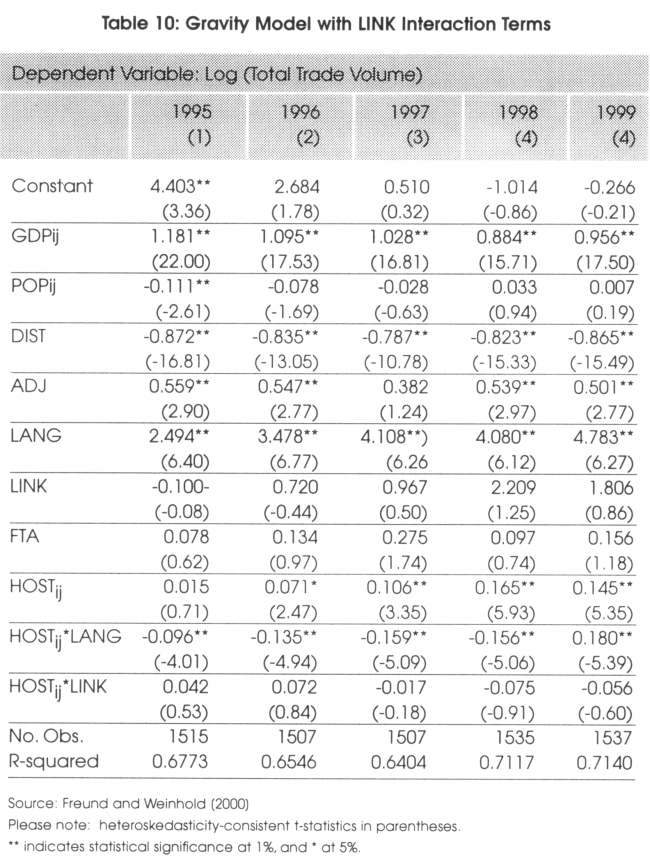
In table 9 RW interact the HOST variable with dummies for a common language and colonial ties. The theory predicts that the Internet will make such ties less important in determining trade patterns, and indeed we find that the coefficient estimates on the interaction variables are negative, and statistically significant for the Language interaction. A possible interpretation of the language interaction result is that perhaps as English becomes something close to a universal language of the Net, having a common native language with your trading partner is becoming less important than simply knowing English. Data limitations preclude us from testing this hypothesis directly, but the policy implications for English-language training are clear. It is common sense as well to realize that to take the fullest possible advantage of any given access to the internet, a command over written English is a huge advantage.
If the empirical results presented in table 7 are taken naively at face value, the one-order of magnitude difference between the quantity of Internet hosts in Bolivia compared to LDC's in general implies that if Bolivia increased its web connectivity to the average of the poorer countries, it's total trade would approximately double4! We wouldn't wish to push these particular implications of the results quite this far, however: the true functional form of the relationship may not be log-linear over all the range, and in addition it is technically incorrect to attribute dynamic causal-relationships to a cross section correlation. Nevertheless it is probably not an exaggeration to conclude that the potential gains, in terms of increased trade, of increased connectivity to the Web could be very large for Bolivia.
4. Conclusions
In any discussion of the potential benefits from increased internet access it is important to mention dynamic considerations. The results presented in FW and in this paper are inherently static in nature. However, there are strong reasons to suspect that some of the most important benefits from investment in knowledge-intensive infrastructure come in the form of dynamic returns. In particular the evidence seems quite convincing that there are significant externalities to education and to knowledge generally, and thus increasing returns to these kinds of investments at the macro-economic level. Better educated people tend to migrate to areas where the average level of education is relatively high - the opposite of what we would expect if there were decreasing returns. If we accept this argument made in much of the endogenous growth literature the impact of the Internet is likely to be three-fold. First, there will be the immediate static impact of increased trade via the channels explored here and in FW. Second, there will be dynamic benefits accrued via increased technological transfer, increased incentives to innovation provided by the larger market, and the subsequent increased returns to schooling - all of the dynamic returns identified in the trade literature of the last 10 years. Third, the growth of the IT sector should generate domestic returns internally that are complementary to the processes instigated by the increased trade.
The endogenous growth literature also hints to a hidden danger of not catching up quickly in terms of access to the international technological frontiers. In particular, due to the increasing returns referred to above, these models predict that initial advantages can translate into an ever increasing advantage, with no strong forces towards convergence at play. Thus a high cost of not investing today in access to technology is not just the forgone benefits calculated above, but also the fact that other countries' lead will be growing ever wider with the chances of catching up in the future getting slimmer each year.
Thus, the message of this paper is at once foreboding but at the same time quite heartening. As we have briefly discussed, many of the models in the endogenous growth literature can imply that developing countries without first-mover advantage may fall further and further behind in the global national income distribution. On the other hand, however, FW and this paper have shown that poor countries can derive a significant benefit from investment in the IT sector and the subsequent increased connectivity to the Internet. In fact we have shown that the impact for poor countries is at least as great as it is for richer countries and can be quite significant.
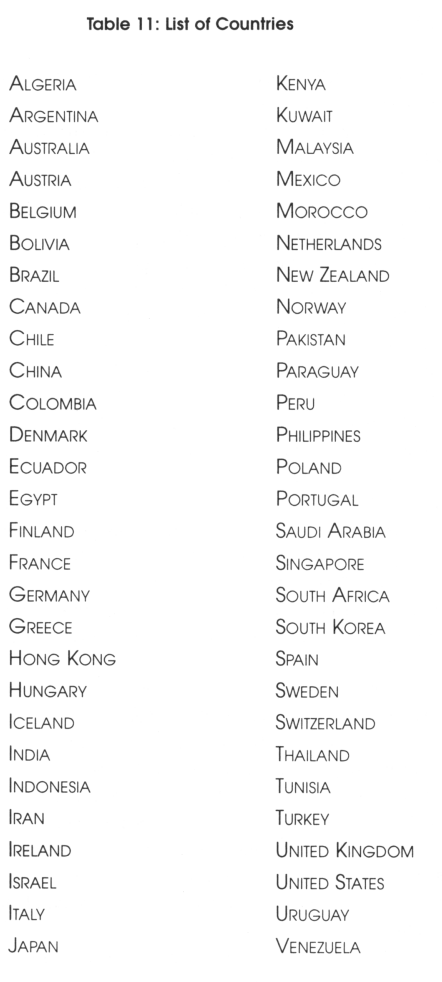
Notes
* This paper was prepared for presentation at the IT workshop in La Paz on December 4, 2000 and constitutes part of the IT component of the Andean Competitiveness Project. Funding from CAF and IISEC is gratefully acknowledged. AN errors and omissions are our own.
** The World Bank, 1818 H Street, NW, Washington D.C. 20433, Email: cfreund@worldbank.org.
*** Development Studies Institute, London School of Economics, Houghton Street, London WC2A 2AE. Email: d.weinhold@lse.ac.uk
1 A large body of empirical work has shown that past linkages and business networks are significant determinants of current trade flows. After controlling for the standard determinants of trade, Eichengreen and Irwin (1998) show that past trade has significant explanatory power in explaining current trade patterns using aggregate trade data. Roberts and Tybout (1997) show a similar effect of history using firm level data. Rauch (1999) finds that colonial linkages and language help explain trade flows.
2 No data was available on the number of computers in Bolivia.
3 These results are available from the author but are not reproduced here to save space.
4 The FW results imply that a 10% increase in relative host sites in one country would increase total trade by approximately 1%. Thus a one order-of-magnitude increase (i.e. 10 times increase) in host sites would imply an increase in total trade on the order of 100%.
REFERENCES
Baldwin, Richard (1988) "Hysteresis in Import Prices: the Beachhead Effect." American Economic Review, 78, 773-785. [ Links ]
Brander, J., and P. Krugman (1983) "A 'Reciprocal Dumping' Model of International Trade". Journal of International Economics 15, 313-323. [ Links ]
Deardorff, Alan V. (1998) "Determinants of Bilateral Trade: Does Gravity Work in a Neoclassical World?" In: J. Frankel (ed.) The Regionalization of the World Economy. Chicago: University of Chicago Press. Internet Software Consortium (http://www.isc.org/) [ Links ]
Eichengreen, B., and D. Irwin (1998) "The Role of History in Bilateral Trade flows." In: J. Frankel (ed.) The Regionalization of the World Economy. Chicago: University of Chicago Press. [ Links ]
Fitzpatrick, Gary L, and Marilyn J. Modlin (1986) Direct-Line Distances (International Edition), The Scarecow Press, Inc. Metuchen, N.J., and London. [ Links ]
Frankel, Jeffrey, E. Stein, and S. J. Wei (1995) "Trade blocks and the Americas: the natural, the Unnatural and the super-natural." Journal of Development Economics No.47 June. [ Links ]
Freund, Caroline, (2000) "Different Paths to Free Trade: The Gains from Regionalism," Quarterly Journal of Economics. Forthcoming November. [ Links ]
Freund, Caroline and Diana Weinhold (2000) "On the Effect of the Internet on International Trade." Draft. November. [ Links ]
Freund, Caroline, and Diana Weinhold (2003) "On the Effect of the Internet on International Trade." (revised version) Journal of International Economics. Forthcoming.
Helliwell, John F. (1996) "Do national borders matter for Quebec's trade?" Canadian Journal of Economics, vol. 29 No. 3, August. [ Links ]
McCallum, John (1995) "National Borders Matter: Canada-US regional trade patterns" American Economic Review, vol.85 No.3, June. [ Links ]
Portes, Richard, and Helene Rey (1999) "The determinants of cross-border equity flows." NBER Working paper # 7336, September. [ Links ]
Quah, Danny (1999) "The weightless economy in economic development" CEP Discussion Paper # 417, February. [ Links ]
Rand McNally and Co. (1994) Historical Atlas of the World, Rand McNally and Company, Chicago. [ Links ]
Rauch, James E. (1996) "Trade and Search: Social Capital, Sogo Shosha, and Spillovers." NBER Working Paper #5618. [ Links ]
Rauch, James E. (1999) "Networks Versus Markets in International Trade." Journal of International Economics 48, 7-35. [ Links ]
Rauch, James E., and Vitor Trindade (2000) "Information and Globalization: Wage Comovements, Labor Demand Elasticity and Conventional Trade Liberalization." NBER Working Paper # 7671, April. [ Links ]
Roberts, M., and J. Tybout (1997) "The Decision to Export in Columbia: An Empirical Model of Entry with Sunk Costs." American Economic Review, 87, 545-564. [ Links ]
Sanders, Matthew (2000a) "Global eCommerce Approaches to Hypergrowth." The Forrester Brief (www.forrester.com), April. [ Links ]
Sanders, Matthew (2000b) "Sizing Global Online Exports" The Forrester Report (www.forrester.com). November. [ Links ]
Wei, Shang-Jin (1996) "Intra-National versus International Trade: How stubborn are Nation States in Globalization?" NBER Working Paper 5331. [ Links ]














